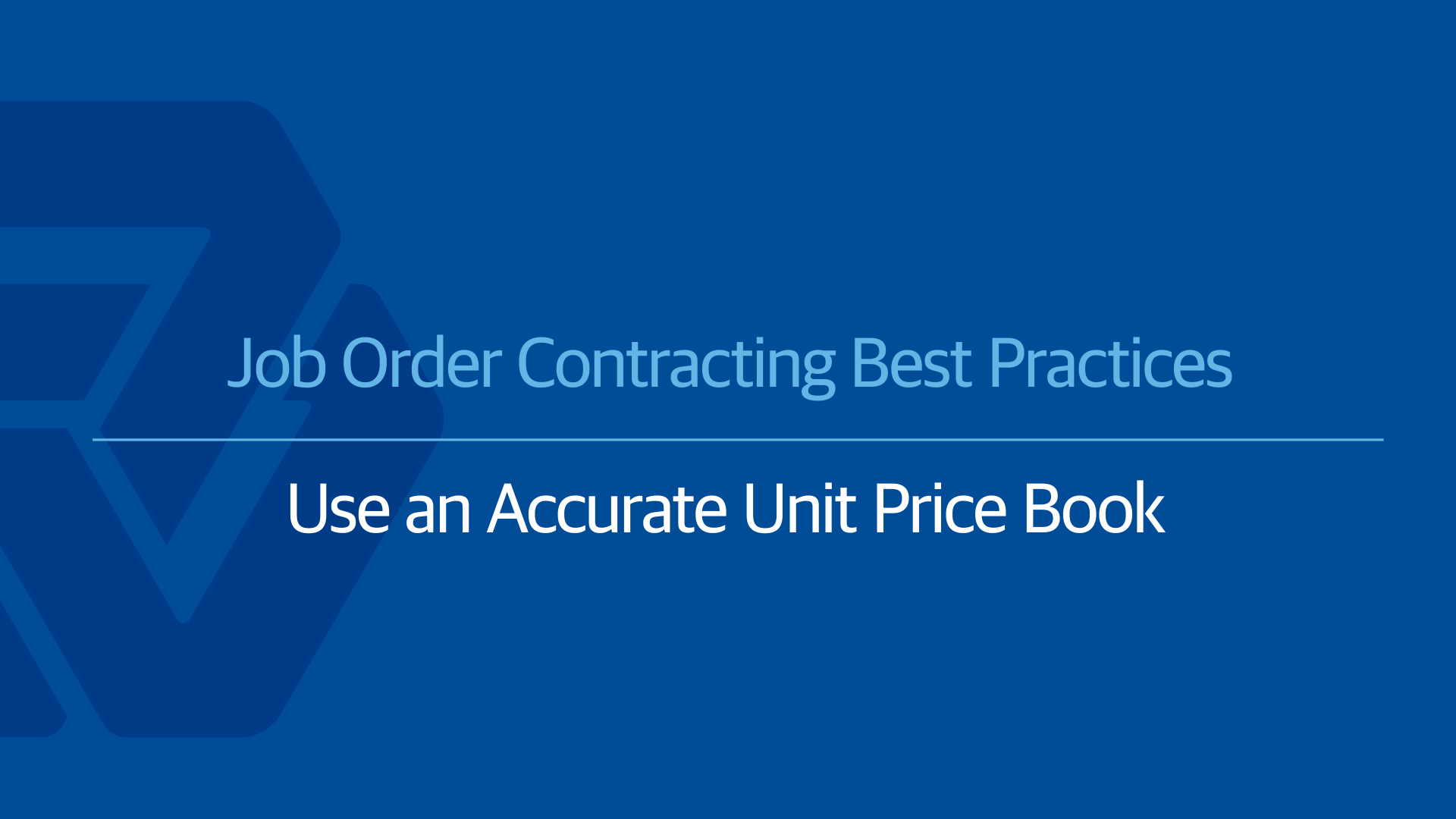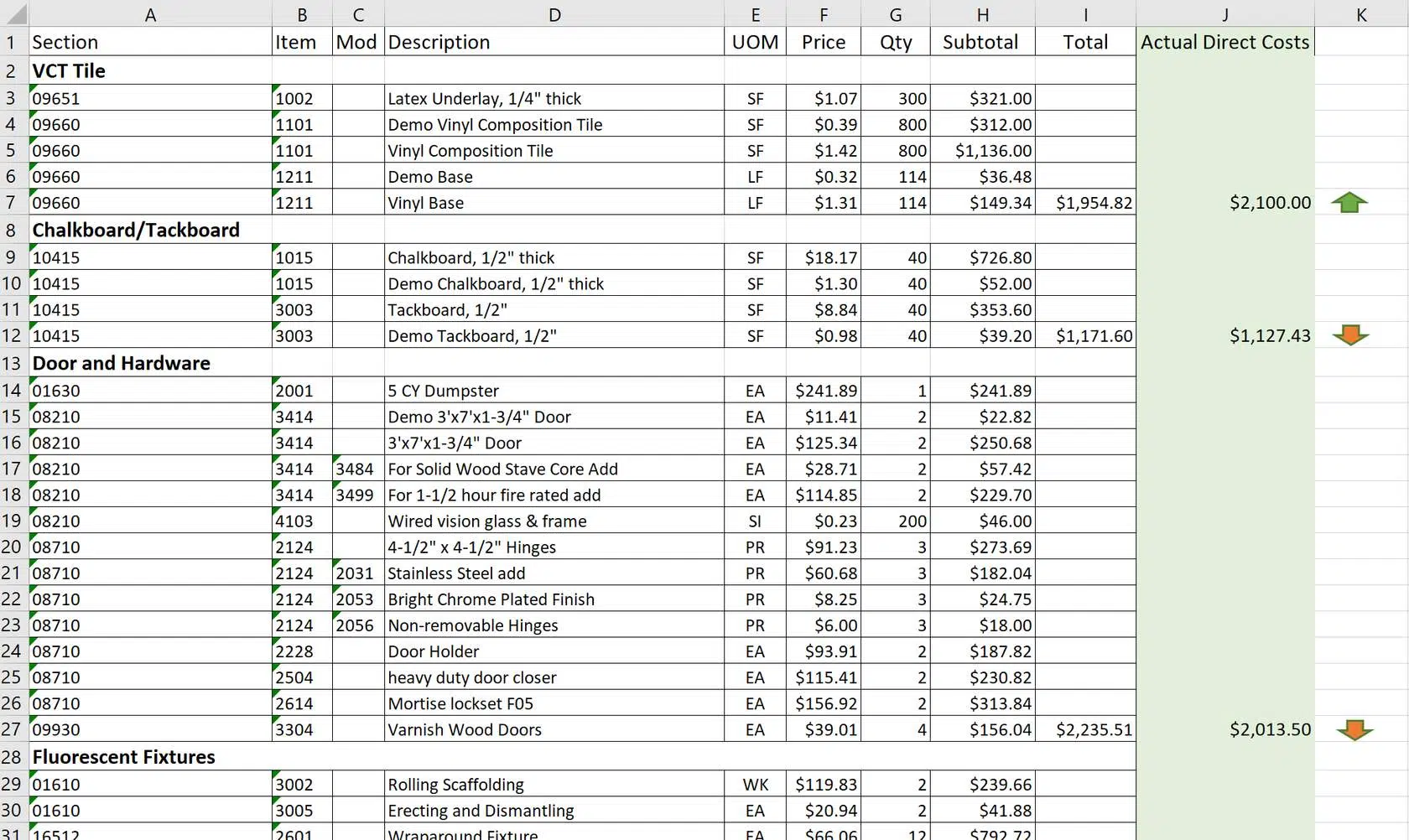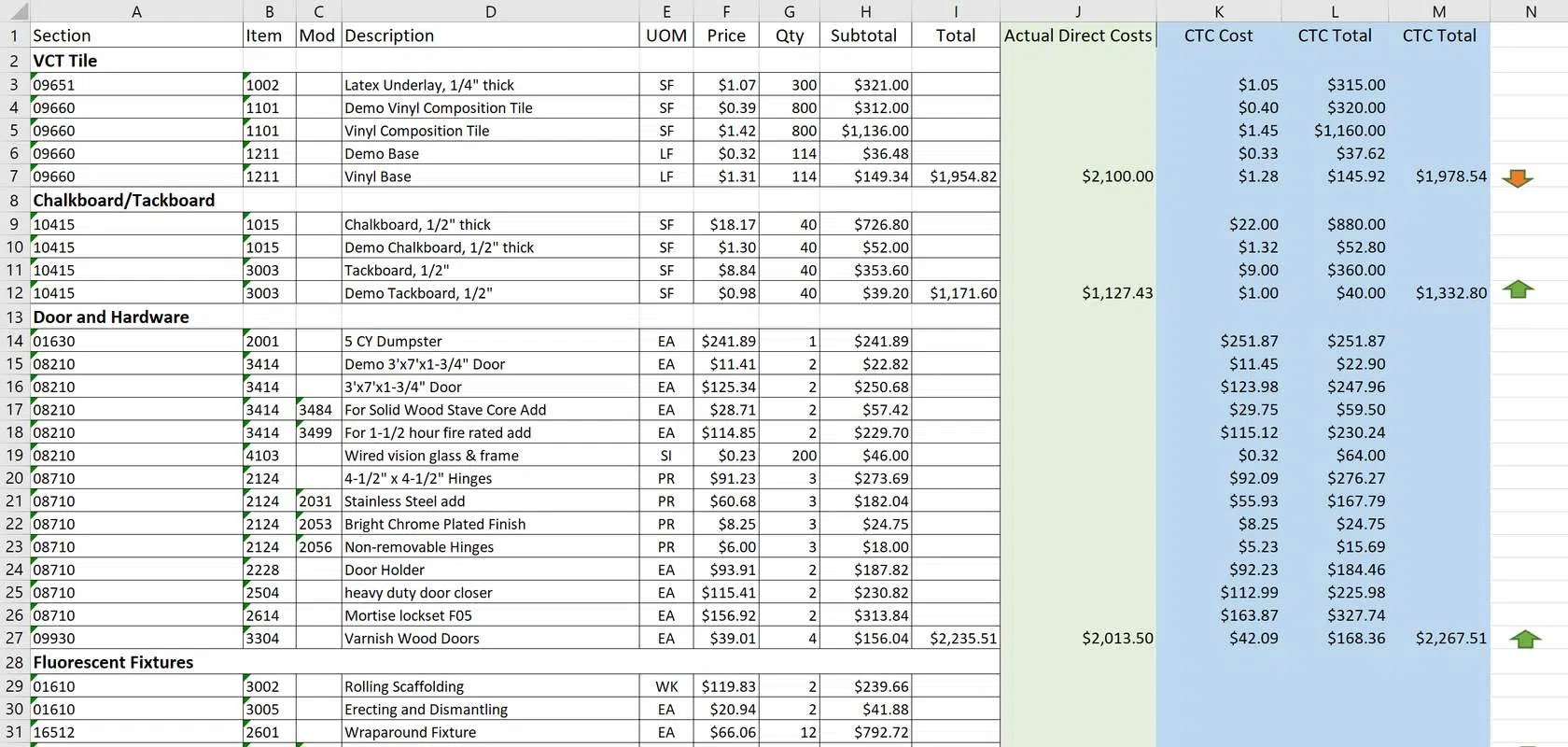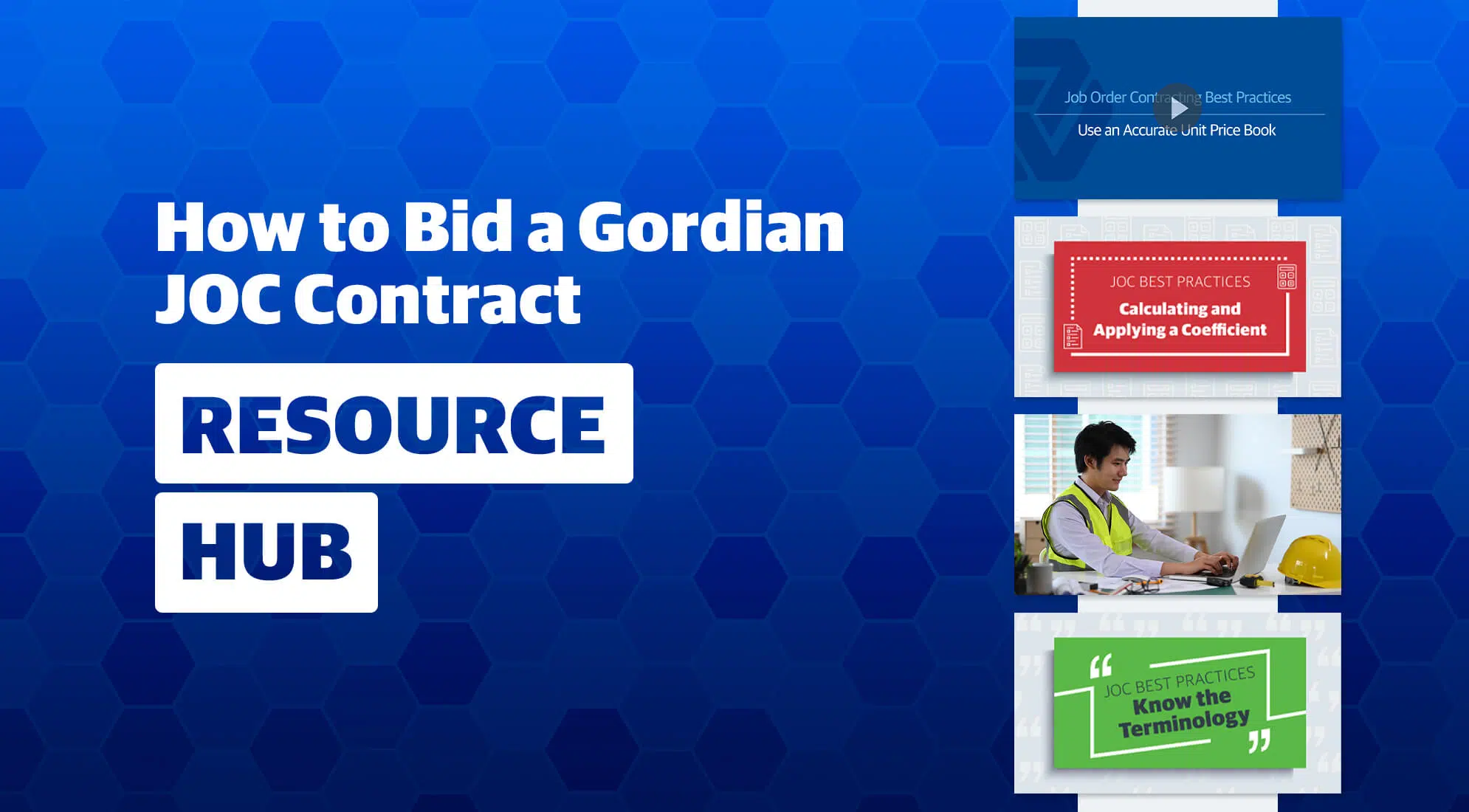Gordian’s Job Order Contracting (JOC) is an indefinite delivery, indefinite quantity (IDIQ) construction delivery method that allows many projects to be completed through a competitively awarded contract. Widely popular in the public sector, this single-solicitation process is a stretch from how contractors are accustomed to bidding work.
With JOC, Adjustment Factors (commonly called coefficients) are the primary criteria owners evaluate to award contractors, so it is vital that contractors are well-versed in creating and applying them. This post explores best practices for calculating a JOC Adjustment Factor, including the costs that must be part of a realistic and successful Adjustment Factor, and applying the Adjustment Factor to a bid.
Let’s start with the basics.
What is a JOC Adjustment Factor?
To obtain an award for a Gordian Job Order Contract, prospective contractors bid an Adjustment Factor on a unit price book with preset prices called a Construction Task Catalog® or CTC for short. The CTC is used to identify necessary line items to build a Price Proposal for each and every Gordian JOC project. In effect, by applying the Adjustment Factor, a contractor is saying “This is how much I need to be paid for these tasks to turn a profit.”
Calculating an Adjustment Factor is just one facet of becoming a Gordian JOC contractor. Visit this page to get more info and learn how a Gordian JOC program can help you expand your business.
Before You Calculate a JOC Adjustment Factor
Before you begin developing your Adjustment Factor, we recommend reviewing the first six pages of the CTC, an introduction titled “Using the Construction Task Catalog.” Those familiar with Gordian JOC may have heard it referred to as The Big Note. Whatever you call this section, these first six pages are important for you to get familiar with because they establish the rules for a Gordian Job Order Contract. This introduction outlines several critical pieces of information, including what is and what is not included in a JOC Adjustment factor. Following these rules may decide whether you are awarded a contract and how much you stand to profit from a JOC program.
Get an idea of what’s in a typical CTC introduction by downloading an example using the button below.
For bidding purposes, the most valuable information outlined in the first six pages of the CTC is what’s included in an Adjustment Factor.
To ensure you receive a fair price for your work and can succeed under a Job Order Contract, an Adjustment Factor should include all direct and indirect costs that are not included in the prices outlined in the CTC, as well as overhead and profit. Subcontractor overhead and profit should be included as well.
For more information about the Gordian Construction Task Catalog, watch this video.
Step One: Examine Your Annual Business Costs
Consider your annual business costs – or overhead – including, but not limited to:
- Office space, personnel and equipment
- Work vehicles, gas and other related costs
- Job order development services, owner meetings and other administrative costs
- Insurance, bonds and indemnification (Note: Payment and performance bonds are reimbursable)
- Regulatory compliance, including permitting & reporting
- Security requirements
- Cooperative purchasing administrative fees, when applicable
- Subcontractors’ overhead & profit
You will also want to account for inherent business risks, as you would with any other construction project. This might include material cost fluctuations, the cost to finance the work or poor subcontractor performance.
Jot down your average, annual business costs. You’ll need them later.
Step Two: Consider Project-Related Costs
You must consider a wealth of project-related costs when developing your Adjustment Factor. Take a moment to review these items and any exceptions or notes that apply.
- Project trailer, equipment and supplies and portable toilets
- If an owner requests any of these items, they can be included as part of the Price Proposal. However, if the items are exclusively for contractor use, they should be calculated into the Adjustment Factor prior to bidding.
- Gang boxes and storage containers for contractor tools, equipment and materials
- Basic safety and warning signage, minor barricades (e.g., construction tape, etc.) and personnel safety equipment (e.g., hard hats, safety harnesses with lifeline or cabling, protective clothing, safety glasses, face shields or COVID-19 specific PPE)
- Items not included in your Adjustment Factor: temporary walls, maintenance and protection of traffic tasks such as temporary signs with sandbags, variable message boards and substantial cabling of floor openings. These will be included as Unit Tasks in your Price proposals, when applicable.
- Costs resulting in an inadequate supply of building materials, fuel, electricity or skilled labor
- Project management and project supervision
- Unit Prices include the cost of labor through the working foreperson level, all other supervision and management should be included in the Adjustment Factor.
- Completing project filings and obtaining permits
- Preparing and modifying sketches, drawings, submittals, as-built drawings, project photographs and other project records
- Sketches and drawings, in this case, are used to justify quantities and are not architectural drawings.
- As-build drawings should be provided in the same media as the original owner-provided drawings. If the owner does not provide drawings, you would not be expected to provide drawings, either.
- Incidental engineering and architectural services
- Anything requiring zero to four hours, or a half-day of an architect’s or engineer’s time is considered incidental. These tasks are commonly considered incidental:
- Identifying the size of lintel for a new opening
- Preparing a sketch showing rebar for a new set of concrete stairs
- Preparing a sketch showing the size and dimensions of an excavation that enables the owner to verify the quantity calculations of materials
- Not producing energy calculations by sizing an HVAC unit for a room
- Anything requiring zero to four hours, or a half-day of an architect’s or engineer’s time is considered incidental. These tasks are commonly considered incidental:
- Security requirements
- Taxes
- Many public agencies do not have to pay the typical tax on material or equipment rental purchases. The owner will provide you with a written tax waiver stating the materials for the project are to be sold to you tax-free. In instances when a waiver is not available (including material sales tax and equipment rental), the taxes should be accounted for in your Adjustment Factor.
- Removing and returning the owner’s furniture and furnishings, including, but not limited to:
- Chairs, tables, pictures, etc.
- Exclude modular furniture, furnishings fastened to the wall or floor, safes and other furniture requiring disassembly
- If there are a significant number of items to be removed from the room, you could be paid for the labor hours required to remove and return those items
- Sealing windows, doors and other openings with plastic to contain construction dust and debris within the work area, or to protect against existing surfaces
- Working in extreme temperatures (below or above normal) or adverse conditions such as rain, wind, sleet or snow
- Daily clean-up
- Final professional clean-up
If there are other items impacting your project costs, be sure to account for those people, items and/or services to appropriately calculate a JOC Adjustment Factor that works for your company. Refer to the solicitation documents for clarity on what is and is not included in your Adjustment Factor.
Step Three: Calculate Your JOC Adjustment Factor
You may have a preferred way to calculate your JOC Adjustment Factor, but based on decades of experience, Gordian has one best-in-class method. To help, we’ve created an Adjustment Factor Calculator to help you practice that method. Review the content first, then plug your company’s respective numbers into the calculator to determine your Adjustment Factor.
Items Needed to Calculate an Adjustment Factor
- Historical scope of work and final project proposals (We recommend using a few project types that your company commonly completes.)
- Construction Task Catalog (CTC) provided with the solicitation document, if available
- Overhead costs, including project-related costs
- Desired profit margin
- Pencil or Excel – whichever you prefer
Trade Contractor Tip
If you have a CTC to reference, focus on the sections specific to your trade. It is unlikely you will be provided with a trade-specific CTC, so you will be able to cross-reference other sections to build your Price Proposal if needed.
Using the JOC Adjustment Factor calculator
Using your historical scope of work and final project proposals, calculate your actual costs and jot down the total amount. This number will go into Box A in the Adjustment Factor Calculator.
Next, take the same scope of work and price it out using the CTC provided with the solicitation. Jot down the total amount. This number will go into Box G in the Adjustment Factor Calculator.
Using your overhead costs, profit, direct costs from historical projects and price from the CTC, fill boxes A, B, D and G with the appropriate dollar amounts and percentages. Boxes C, E, F and H will populate automatically.
The number provided in the Adjustment Factor box becomes an option for your company. We recommend going through this exercise a few times to ensure you are confident calculating a JOC Adjustment Factor and that your company can be profitable under a JOC program.Note: It is the contractor’s responsibility to calculate and determine the Adjustment Factor(s) that are viable for their company. The information provided here is for reference and the calculator is a tool to calculate possible Adjustment Factor(s). Gordian cannot be held responsible for any Adjustment Factor(s) included within bid responses.

Each Job Order Contract requires multiple Adjustment Factors based on the owner’s specifications. You will want to review the solicitation documents to understand what Adjustment Factors are needed, then perform this exercise for each one.
The JOC Adjustment Factor in Action
If awarded a contract, you’ll apply your Adjustment Factor to each line item in a Price Proposal. Each task on that Price Proposal consists of a Unit Price multiplied by the necessary quantity multiplied by the appropriate Adjustment Factor. The total is how much you’ll be paid for each task.
Fair and Realistic JOC Adjustment Factors are Foundational to Contractor Success
These steps, resources and tips are intended to help you develop Adjustment Factors that result in successful bids, awarded Gordian Job Order Contracts and long-term profitability. Calculate “practice” JOC Adjustment Factors until you feel confident enough to bid on the next opportunity in your area.









